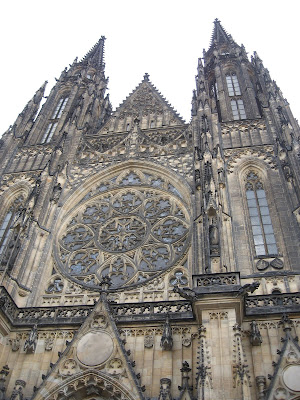We are starting to really get our feet under us now. The trains are fast, easy and convenient. For the second city in a row, we were able to walk from the train station to our hotel, carrying our luggage. And, it was nothing much more than a casual stroll. It is amazing how these Eastern European cities, which are large cities, have most of their sightseeing in a small, easily navigated, old inner city.
While we did take the subway occasionally in Prague, and found it easy and convenient, we discovered is was just as easy to walk to most of what we wanted to see. And, of course, there is a lot to see.
We started with the Charles Bridge, named after Charles IV. This bridge, which crosses the river and was built in the 14th century, is a major center of activity in Prague. All along it, there were musicians, vendors, statues and lots of people. At times, there were so many people we could hardly get through the crowds.
 Here is the gate to the old city at one end of the Charles Bridge.
Here is the gate to the old city at one end of the Charles Bridge.
Here is a statue of a priest who heard the confession of the King's wife. The king demanded to know what she had said. When the priest refused, he was thrown off the bridge. When he hit the water, tradition says stars appeared in the water. Thus the stars around his head. Supposedly, if you make a wish by touching the statue, it will come true (I tried to talk Dee into kissing it, 'cause it works better than way.).

Then, there was the Prague Castle. We happened to arrive just in time for the changing of the guard.

Just across the river from the old town, is Pertin hill and tower, an amazingly quiet and beautiful oasis from the city. We tool the Charles Bridge across, then the funicular up to see these sights. Here is a garden at the top of the hill, then a view of the river and Charles Bridge. Finally, a view of the castle.



Jewish Quarter/Cemetery. I was not aware that Prague was one of the main Jewish areas in Europe. A significant number of the Jews who went to Auschwitz and other concentration camps were from Prague. I also was not aware the Jews had been persecuted for centuries prior to the Nazis. In the cemetery, the area is raised several feet because they were forced to remain in the small Jewish Quarter and bury their dead in this small area for centuries, and consequently had to bury them one on top of the other. Then, the Nazis come along and destroy the cemetery, taking the tombstones to grind up for road construction. Some pieces survived and are built into the wall, and many of the tombstones have been replaced by relatives since the war. Then, Hitler built a museum celebrating the upcoming extinction of the Jewish race. I new it was bad, of course, but I was still surprised and appalled just seeing some of the things the Nazis did.


Of course, you see amazing churches in every city. Here are some samples from Prague.


Then there is Wencesla Square. Here is a view of the square. Then there is the Europa Hotel on the square. Havel stood in the balcony and spoke to a crowd of 300,000 as Czechoslavakia gained its independence from the Soviet Union.



No comments:
Post a Comment